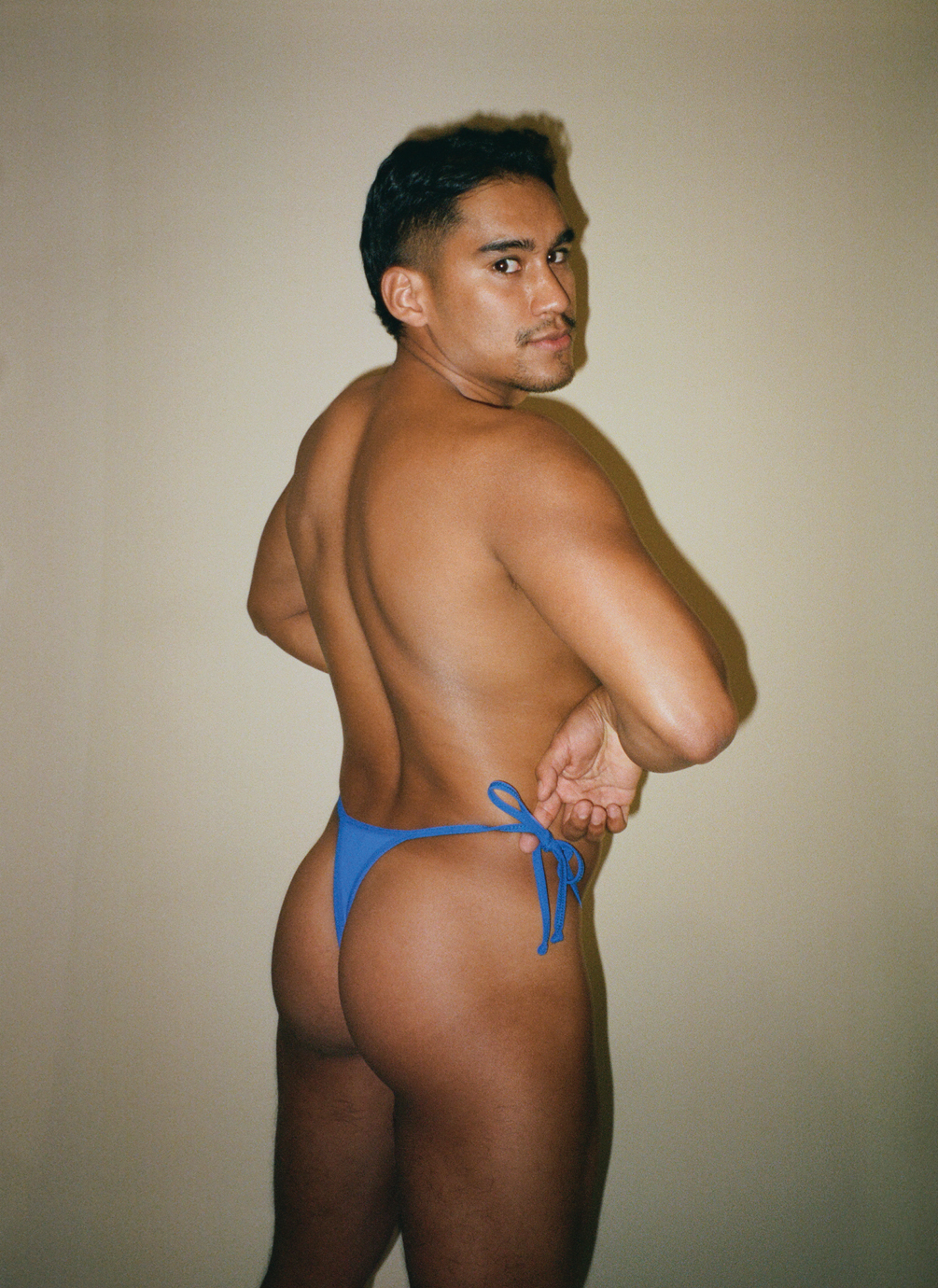A SHORT HISTORY OF THE THONG
TEXT BY SHIV KOTECHA
PHOTOGRAPHY BY ABI BENITEZ











DAVID WEARS THONG BY SYS COMPANY.
The evolution of the Y-shaped form known as a thong spans an inspired reversal of function: from a cord used to yoke shoes to feet, to the solitary strip meant to liberate the ass, the latter usage made popular after Austrian-American fashion designer Rudi Gernreich reinvented the minimalist garment in 1974. Nearly four centuries prior, William Shakespeare anticipates this turn from adherence to emancipation — a horse, in his play Venus and Adonis, inspired by a passing mare’s beauty, throws off his thong, this time a riding crop delivering bondage, to give his backside free rein:
Throwing the base thong from his bending crest, Enfranchising his mouth, his back, his breast.
“Free your mind…, and your ass will follow,” Funkadelic preached with the title of their second album. It’s good advice — though I’ve yet to take it. The only thong I’ve ever owned was given to me by my high school best friend Kim; it was red crushed velvet and meant to resemble Santa Claus’s stocking cap turned upside down, complete with a white puff ball dangling at the sac’s end. I never put the thong on, not even to see what my ass would look like in its frame or how free my mind would feel, still too closeted a boy to know about the pleasure of placing the thong’s strip between my cheeks. This feature, originally a part of the jockstrap, a garment since redesigned for maximal access, in the said holiday-themed underpant, suggested a rude impediment to Santa’s passage down the chimney, albeit a flimsy one. But this was the early aughts, just after Sisqó’s infamous stutter — thong-th-thong-thong-thong — which in retrospect seemed to articulate my shy refusal to don the gift, had ushered in the thong’s ubiquity. The mega-hit’s video finds the Spring Break bardo in a near trance, fixated on a rump so unfettered by the thong that the ass becomes one with the beat — da na da na, baby, make your booty go, da na da na — as if this thin sliver of a garment were all we ever needed to frame the feeling of pure immanence.
A decade after Gernreich introduced his tits-out monokini, a garment condemned by both the Vatican and the Soviet Union during the post-sexual revolution ‘70s, the designer invented the thong as a one-piece swimsuit for all genders. The goal was to get as close as possible to public nudity while still abiding by the city of Los Angeles’s ban against nude sunbathing.
Gernreich’s interest in “unisex” fashion was not an invitation for women to dress more like men, but for men to return to dressing well. In its later sartorial iterations, the thong went from revelation (exposing as much skin as possible to sunlight) to obfuscation (sparing onlookers evidence of a pantyline) to suggestion (as in the whale tail, reminding us there’s an ass under even the thickest denim). Some eschew the thong, especially the notorious G-string, for medical reasons, though scientific trials have vindicated fashion’s butt floss from accusations that it serves as a back-to-front vehicle for either bacterial or fungal transport. And yet others continue to wait patiently for an option where comfort and stimulation might find better alignment: “lmk,” a friend recently asked of me, “if you find out about a contemporary thong that doesn’t cut off clitoral circulation (and sorry for the tmi!!!).”
The thong is an ideal garment for maintaining contradiction: for hiding the cosmos of one’s genitals while letting it all hang out; a loosening of the reins that leads to sensuous repurposing. The thong asks us to imagine the limits of what we can take off without returning, fully, to a state of nature. Personally, I like picturing the disaffected young men of Aurelio Guo’s book-length poem NYT (Gauss PDF 2018), those “Loser sons of successful fathers / Drinking coca cola from a plastic bottle in the grey sand in a black thong.” Those who aspire to be winners instead might opt for a bright color, the better to attract the attention of the hottest horse.
This story was printed in GAYLETTER Issue 15, get a copy here.
JON WEARS THONG BY SYS COMPANY.
The evolution of the Y-shaped form known as a thong spans an inspired reversal of function: from a cord used to yoke shoes to feet, to the solitary strip meant to liberate the ass, the latter usage made popular after Austrian-American fashion designer Rudi Gernreich reinvented the minimalist garment in 1974. Nearly four centuries prior, William Shakespeare anticipates this turn from adherence to emancipation — a horse, in his play Venus and Adonis, inspired by a passing mare’s beauty, throws off his thong, this time a riding crop delivering bondage, to give his backside free rein:
Throwing the base thong from his bending crest, Enfranchising his mouth, his back, his breast.
“Free your mind…, and your ass will follow,” Funkadelic preached with the title of their second album. It’s good advice — though I’ve yet to take it. The only thong I’ve ever owned was given to me by my high school best friend Kim; it was red crushed velvet and meant to resemble Santa Claus’s stocking cap turned upside down, complete with a white puff ball dangling at the sac’s end. I never put the thong on, not even to see what my ass would look like in its frame or how free my mind would feel, still too closeted a boy to know about the pleasure of placing the thong’s strip between my cheeks. This feature, originally a part of the jockstrap, a garment since redesigned for maximal access, in the said holiday-themed underpant, suggested a rude impediment to Santa’s passage down the chimney, albeit a flimsy one. But this was the early aughts, just after Sisqó’s infamous stutter — thong-th-thong-thong-thong — which in retrospect seemed to articulate my shy refusal to don the gift, had ushered in the thong’s ubiquity. The mega-hit’s video finds the Spring Break bardo in a near trance, fixated on a rump so unfettered by the thong that the ass becomes one with the beat — da na da na, baby, make your booty go, da na da na — as if this thin sliver of a garment were all we ever needed to frame the feeling of pure immanence.
A decade after Gernreich introduced his tits-out monokini, a garment condemned by both the Vatican and the Soviet Union during the post-sexual revolution ‘70s, the designer invented the thong as a one-piece swimsuit for all genders. The goal was to get as close as possible to public nudity while still abiding by the city of Los Angeles’s ban against nude sunbathing.
Gernreich’s interest in “unisex” fashion was not an invitation for women to dress more like men, but for men to return to dressing well. In its later sartorial iterations, the thong went from revelation (exposing as much skin as possible to sunlight) to obfuscation (sparing onlookers evidence of a pantyline) to suggestion (as in the whale tail, reminding us there’s an ass under even the thickest denim). Some eschew the thong, especially the notorious G-string, for medical reasons, though scientific trials have vindicated fashion’s butt floss from accusations that it serves as a back-to-front vehicle for either bacterial or fungal transport. And yet others continue to wait patiently for an option where comfort and stimulation might find better alignment: “lmk,” a friend recently asked of me, “if you find out about a contemporary thong that doesn’t cut off clitoral circulation (and sorry for the tmi!!!).”
The thong is an ideal garment for maintaining contradiction: for hiding the cosmos of one’s genitals while letting it all hang out; a loosening of the reins that leads to sensuous repurposing. The thong asks us to imagine the limits of what we can take off without returning, fully, to a state of nature. Personally, I like picturing the disaffected young men of Aurelio Guo’s book-length poem NYT (Gauss PDF 2018), those “Loser sons of successful fathers / Drinking coca cola from a plastic bottle in the grey sand in a black thong.” Those who aspire to be winners instead might opt for a bright color, the better to attract the attention of the hottest horse.
This story was printed in GAYLETTER Issue 15, get a copy here.
DAVID WEARS THONG BY RUFSKIN.
The evolution of the Y-shaped form known as a thong spans an inspired reversal of function: from a cord used to yoke shoes to feet, to the solitary strip meant to liberate the ass, the latter usage made popular after Austrian-American fashion designer Rudi Gernreich reinvented the minimalist garment in 1974. Nearly four centuries prior, William Shakespeare anticipates this turn from adherence to emancipation — a horse, in his play Venus and Adonis, inspired by a passing mare’s beauty, throws off his thong, this time a riding crop delivering bondage, to give his backside free rein:
Throwing the base thong from his bending crest, Enfranchising his mouth, his back, his breast.
“Free your mind…, and your ass will follow,” Funkadelic preached with the title of their second album. It’s good advice — though I’ve yet to take it. The only thong I’ve ever owned was given to me by my high school best friend Kim; it was red crushed velvet and meant to resemble Santa Claus’s stocking cap turned upside down, complete with a white puff ball dangling at the sac’s end. I never put the thong on, not even to see what my ass would look like in its frame or how free my mind would feel, still too closeted a boy to know about the pleasure of placing the thong’s strip between my cheeks. This feature, originally a part of the jockstrap, a garment since redesigned for maximal access, in the said holiday-themed underpant, suggested a rude impediment to Santa’s passage down the chimney, albeit a flimsy one. But this was the early aughts, just after Sisqó’s infamous stutter — thong-th-thong-thong-thong — which in retrospect seemed to articulate my shy refusal to don the gift, had ushered in the thong’s ubiquity. The mega-hit’s video finds the Spring Break bardo in a near trance, fixated on a rump so unfettered by the thong that the ass becomes one with the beat — da na da na, baby, make your booty go, da na da na — as if this thin sliver of a garment were all we ever needed to frame the feeling of pure immanence.
A decade after Gernreich introduced his tits-out monokini, a garment condemned by both the Vatican and the Soviet Union during the post-sexual revolution ‘70s, the designer invented the thong as a one-piece swimsuit for all genders. The goal was to get as close as possible to public nudity while still abiding by the city of Los Angeles’s ban against nude sunbathing.
Gernreich’s interest in “unisex” fashion was not an invitation for women to dress more like men, but for men to return to dressing well. In its later sartorial iterations, the thong went from revelation (exposing as much skin as possible to sunlight) to obfuscation (sparing onlookers evidence of a pantyline) to suggestion (as in the whale tail, reminding us there’s an ass under even the thickest denim). Some eschew the thong, especially the notorious G-string, for medical reasons, though scientific trials have vindicated fashion’s butt floss from accusations that it serves as a back-to-front vehicle for either bacterial or fungal transport. And yet others continue to wait patiently for an option where comfort and stimulation might find better alignment: “lmk,” a friend recently asked of me, “if you find out about a contemporary thong that doesn’t cut off clitoral circulation (and sorry for the tmi!!!).”
The thong is an ideal garment for maintaining contradiction: for hiding the cosmos of one’s genitals while letting it all hang out; a loosening of the reins that leads to sensuous repurposing. The thong asks us to imagine the limits of what we can take off without returning, fully, to a state of nature. Personally, I like picturing the disaffected young men of Aurelio Guo’s book-length poem NYT (Gauss PDF 2018), those “Loser sons of successful fathers / Drinking coca cola from a plastic bottle in the grey sand in a black thong.” Those who aspire to be winners instead might opt for a bright color, the better to attract the attention of the hottest horse.
This story was printed in GAYLETTER Issue 15, get a copy here.
DAVID WEARS THONG BY KVRT STVFF.
The evolution of the Y-shaped form known as a thong spans an inspired reversal of function: from a cord used to yoke shoes to feet, to the solitary strip meant to liberate the ass, the latter usage made popular after Austrian-American fashion designer Rudi Gernreich reinvented the minimalist garment in 1974. Nearly four centuries prior, William Shakespeare anticipates this turn from adherence to emancipation — a horse, in his play Venus and Adonis, inspired by a passing mare’s beauty, throws off his thong, this time a riding crop delivering bondage, to give his backside free rein:
Throwing the base thong from his bending crest, Enfranchising his mouth, his back, his breast.
“Free your mind…, and your ass will follow,” Funkadelic preached with the title of their second album. It’s good advice — though I’ve yet to take it. The only thong I’ve ever owned was given to me by my high school best friend Kim; it was red crushed velvet and meant to resemble Santa Claus’s stocking cap turned upside down, complete with a white puff ball dangling at the sac’s end. I never put the thong on, not even to see what my ass would look like in its frame or how free my mind would feel, still too closeted a boy to know about the pleasure of placing the thong’s strip between my cheeks. This feature, originally a part of the jockstrap, a garment since redesigned for maximal access, in the said holiday-themed underpant, suggested a rude impediment to Santa’s passage down the chimney, albeit a flimsy one. But this was the early aughts, just after Sisqó’s infamous stutter — thong-th-thong-thong-thong — which in retrospect seemed to articulate my shy refusal to don the gift, had ushered in the thong’s ubiquity. The mega-hit’s video finds the Spring Break bardo in a near trance, fixated on a rump so unfettered by the thong that the ass becomes one with the beat — da na da na, baby, make your booty go, da na da na — as if this thin sliver of a garment were all we ever needed to frame the feeling of pure immanence.
A decade after Gernreich introduced his tits-out monokini, a garment condemned by both the Vatican and the Soviet Union during the post-sexual revolution ‘70s, the designer invented the thong as a one-piece swimsuit for all genders. The goal was to get as close as possible to public nudity while still abiding by the city of Los Angeles’s ban against nude sunbathing.
Gernreich’s interest in “unisex” fashion was not an invitation for women to dress more like men, but for men to return to dressing well. In its later sartorial iterations, the thong went from revelation (exposing as much skin as possible to sunlight) to obfuscation (sparing onlookers evidence of a pantyline) to suggestion (as in the whale tail, reminding us there’s an ass under even the thickest denim). Some eschew the thong, especially the notorious G-string, for medical reasons, though scientific trials have vindicated fashion’s butt floss from accusations that it serves as a back-to-front vehicle for either bacterial or fungal transport. And yet others continue to wait patiently for an option where comfort and stimulation might find better alignment: “lmk,” a friend recently asked of me, “if you find out about a contemporary thong that doesn’t cut off clitoral circulation (and sorry for the tmi!!!).”
The thong is an ideal garment for maintaining contradiction: for hiding the cosmos of one’s genitals while letting it all hang out; a loosening of the reins that leads to sensuous repurposing. The thong asks us to imagine the limits of what we can take off without returning, fully, to a state of nature. Personally, I like picturing the disaffected young men of Aurelio Guo’s book-length poem NYT (Gauss PDF 2018), those “Loser sons of successful fathers / Drinking coca cola from a plastic bottle in the grey sand in a black thong.” Those who aspire to be winners instead might opt for a bright color, the better to attract the attention of the hottest horse.
This story was printed in GAYLETTER Issue 15, get a copy here.
DAVID WEARS THONG BY KVRT STVFF.
The evolution of the Y-shaped form known as a thong spans an inspired reversal of function: from a cord used to yoke shoes to feet, to the solitary strip meant to liberate the ass, the latter usage made popular after Austrian-American fashion designer Rudi Gernreich reinvented the minimalist garment in 1974. Nearly four centuries prior, William Shakespeare anticipates this turn from adherence to emancipation — a horse, in his play Venus and Adonis, inspired by a passing mare’s beauty, throws off his thong, this time a riding crop delivering bondage, to give his backside free rein:
Throwing the base thong from his bending crest, Enfranchising his mouth, his back, his breast.
“Free your mind…, and your ass will follow,” Funkadelic preached with the title of their second album. It’s good advice — though I’ve yet to take it. The only thong I’ve ever owned was given to me by my high school best friend Kim; it was red crushed velvet and meant to resemble Santa Claus’s stocking cap turned upside down, complete with a white puff ball dangling at the sac’s end. I never put the thong on, not even to see what my ass would look like in its frame or how free my mind would feel, still too closeted a boy to know about the pleasure of placing the thong’s strip between my cheeks. This feature, originally a part of the jockstrap, a garment since redesigned for maximal access, in the said holiday-themed underpant, suggested a rude impediment to Santa’s passage down the chimney, albeit a flimsy one. But this was the early aughts, just after Sisqó’s infamous stutter — thong-th-thong-thong-thong — which in retrospect seemed to articulate my shy refusal to don the gift, had ushered in the thong’s ubiquity. The mega-hit’s video finds the Spring Break bardo in a near trance, fixated on a rump so unfettered by the thong that the ass becomes one with the beat — da na da na, baby, make your booty go, da na da na — as if this thin sliver of a garment were all we ever needed to frame the feeling of pure immanence.
A decade after Gernreich introduced his tits-out monokini, a garment condemned by both the Vatican and the Soviet Union during the post-sexual revolution ‘70s, the designer invented the thong as a one-piece swimsuit for all genders. The goal was to get as close as possible to public nudity while still abiding by the city of Los Angeles’s ban against nude sunbathing.
Gernreich’s interest in “unisex” fashion was not an invitation for women to dress more like men, but for men to return to dressing well. In its later sartorial iterations, the thong went from revelation (exposing as much skin as possible to sunlight) to obfuscation (sparing onlookers evidence of a pantyline) to suggestion (as in the whale tail, reminding us there’s an ass under even the thickest denim). Some eschew the thong, especially the notorious G-string, for medical reasons, though scientific trials have vindicated fashion’s butt floss from accusations that it serves as a back-to-front vehicle for either bacterial or fungal transport. And yet others continue to wait patiently for an option where comfort and stimulation might find better alignment: “lmk,” a friend recently asked of me, “if you find out about a contemporary thong that doesn’t cut off clitoral circulation (and sorry for the tmi!!!).”
The thong is an ideal garment for maintaining contradiction: for hiding the cosmos of one’s genitals while letting it all hang out; a loosening of the reins that leads to sensuous repurposing. The thong asks us to imagine the limits of what we can take off without returning, fully, to a state of nature. Personally, I like picturing the disaffected young men of Aurelio Guo’s book-length poem NYT (Gauss PDF 2018), those “Loser sons of successful fathers / Drinking coca cola from a plastic bottle in the grey sand in a black thong.” Those who aspire to be winners instead might opt for a bright color, the better to attract the attention of the hottest horse.
This story was printed in GAYLETTER Issue 15, get a copy here.
MATEO WEARS THONG BY KVRT STVFF.
The evolution of the Y-shaped form known as a thong spans an inspired reversal of function: from a cord used to yoke shoes to feet, to the solitary strip meant to liberate the ass, the latter usage made popular after Austrian-American fashion designer Rudi Gernreich reinvented the minimalist garment in 1974. Nearly four centuries prior, William Shakespeare anticipates this turn from adherence to emancipation — a horse, in his play Venus and Adonis, inspired by a passing mare’s beauty, throws off his thong, this time a riding crop delivering bondage, to give his backside free rein:
Throwing the base thong from his bending crest, Enfranchising his mouth, his back, his breast.
“Free your mind…, and your ass will follow,” Funkadelic preached with the title of their second album. It’s good advice — though I’ve yet to take it. The only thong I’ve ever owned was given to me by my high school best friend Kim; it was red crushed velvet and meant to resemble Santa Claus’s stocking cap turned upside down, complete with a white puff ball dangling at the sac’s end. I never put the thong on, not even to see what my ass would look like in its frame or how free my mind would feel, still too closeted a boy to know about the pleasure of placing the thong’s strip between my cheeks. This feature, originally a part of the jockstrap, a garment since redesigned for maximal access, in the said holiday-themed underpant, suggested a rude impediment to Santa’s passage down the chimney, albeit a flimsy one. But this was the early aughts, just after Sisqó’s infamous stutter — thong-th-thong-thong-thong — which in retrospect seemed to articulate my shy refusal to don the gift, had ushered in the thong’s ubiquity. The mega-hit’s video finds the Spring Break bardo in a near trance, fixated on a rump so unfettered by the thong that the ass becomes one with the beat — da na da na, baby, make your booty go, da na da na — as if this thin sliver of a garment were all we ever needed to frame the feeling of pure immanence.
A decade after Gernreich introduced his tits-out monokini, a garment condemned by both the Vatican and the Soviet Union during the post-sexual revolution ‘70s, the designer invented the thong as a one-piece swimsuit for all genders. The goal was to get as close as possible to public nudity while still abiding by the city of Los Angeles’s ban against nude sunbathing.
Gernreich’s interest in “unisex” fashion was not an invitation for women to dress more like men, but for men to return to dressing well. In its later sartorial iterations, the thong went from revelation (exposing as much skin as possible to sunlight) to obfuscation (sparing onlookers evidence of a pantyline) to suggestion (as in the whale tail, reminding us there’s an ass under even the thickest denim). Some eschew the thong, especially the notorious G-string, for medical reasons, though scientific trials have vindicated fashion’s butt floss from accusations that it serves as a back-to-front vehicle for either bacterial or fungal transport. And yet others continue to wait patiently for an option where comfort and stimulation might find better alignment: “lmk,” a friend recently asked of me, “if you find out about a contemporary thong that doesn’t cut off clitoral circulation (and sorry for the tmi!!!).”
The thong is an ideal garment for maintaining contradiction: for hiding the cosmos of one’s genitals while letting it all hang out; a loosening of the reins that leads to sensuous repurposing. The thong asks us to imagine the limits of what we can take off without returning, fully, to a state of nature. Personally, I like picturing the disaffected young men of Aurelio Guo’s book-length poem NYT (Gauss PDF 2018), those “Loser sons of successful fathers / Drinking coca cola from a plastic bottle in the grey sand in a black thong.” Those who aspire to be winners instead might opt for a bright color, the better to attract the attention of the hottest horse.
This story was printed in GAYLETTER Issue 15, get a copy here.
GABE WEARS THONG BY KVRT STVFF.
The evolution of the Y-shaped form known as a thong spans an inspired reversal of function: from a cord used to yoke shoes to feet, to the solitary strip meant to liberate the ass, the latter usage made popular after Austrian-American fashion designer Rudi Gernreich reinvented the minimalist garment in 1974. Nearly four centuries prior, William Shakespeare anticipates this turn from adherence to emancipation — a horse, in his play Venus and Adonis, inspired by a passing mare’s beauty, throws off his thong, this time a riding crop delivering bondage, to give his backside free rein:
Throwing the base thong from his bending crest, Enfranchising his mouth, his back, his breast.
“Free your mind…, and your ass will follow,” Funkadelic preached with the title of their second album. It’s good advice — though I’ve yet to take it. The only thong I’ve ever owned was given to me by my high school best friend Kim; it was red crushed velvet and meant to resemble Santa Claus’s stocking cap turned upside down, complete with a white puff ball dangling at the sac’s end. I never put the thong on, not even to see what my ass would look like in its frame or how free my mind would feel, still too closeted a boy to know about the pleasure of placing the thong’s strip between my cheeks. This feature, originally a part of the jockstrap, a garment since redesigned for maximal access, in the said holiday-themed underpant, suggested a rude impediment to Santa’s passage down the chimney, albeit a flimsy one. But this was the early aughts, just after Sisqó’s infamous stutter — thong-th-thong-thong-thong — which in retrospect seemed to articulate my shy refusal to don the gift, had ushered in the thong’s ubiquity. The mega-hit’s video finds the Spring Break bardo in a near trance, fixated on a rump so unfettered by the thong that the ass becomes one with the beat — da na da na, baby, make your booty go, da na da na — as if this thin sliver of a garment were all we ever needed to frame the feeling of pure immanence.
A decade after Gernreich introduced his tits-out monokini, a garment condemned by both the Vatican and the Soviet Union during the post-sexual revolution ‘70s, the designer invented the thong as a one-piece swimsuit for all genders. The goal was to get as close as possible to public nudity while still abiding by the city of Los Angeles’s ban against nude sunbathing.
Gernreich’s interest in “unisex” fashion was not an invitation for women to dress more like men, but for men to return to dressing well. In its later sartorial iterations, the thong went from revelation (exposing as much skin as possible to sunlight) to obfuscation (sparing onlookers evidence of a pantyline) to suggestion (as in the whale tail, reminding us there’s an ass under even the thickest denim). Some eschew the thong, especially the notorious G-string, for medical reasons, though scientific trials have vindicated fashion’s butt floss from accusations that it serves as a back-to-front vehicle for either bacterial or fungal transport. And yet others continue to wait patiently for an option where comfort and stimulation might find better alignment: “lmk,” a friend recently asked of me, “if you find out about a contemporary thong that doesn’t cut off clitoral circulation (and sorry for the tmi!!!).”
The thong is an ideal garment for maintaining contradiction: for hiding the cosmos of one’s genitals while letting it all hang out; a loosening of the reins that leads to sensuous repurposing. The thong asks us to imagine the limits of what we can take off without returning, fully, to a state of nature. Personally, I like picturing the disaffected young men of Aurelio Guo’s book-length poem NYT (Gauss PDF 2018), those “Loser sons of successful fathers / Drinking coca cola from a plastic bottle in the grey sand in a black thong.” Those who aspire to be winners instead might opt for a bright color, the better to attract the attention of the hottest horse.
This story was printed in GAYLETTER Issue 15, get a copy here.
GABE WEARS THONG BY KVRT STVFF.
The evolution of the Y-shaped form known as a thong spans an inspired reversal of function: from a cord used to yoke shoes to feet, to the solitary strip meant to liberate the ass, the latter usage made popular after Austrian-American fashion designer Rudi Gernreich reinvented the minimalist garment in 1974. Nearly four centuries prior, William Shakespeare anticipates this turn from adherence to emancipation — a horse, in his play Venus and Adonis, inspired by a passing mare’s beauty, throws off his thong, this time a riding crop delivering bondage, to give his backside free rein:
Throwing the base thong from his bending crest, Enfranchising his mouth, his back, his breast.
“Free your mind…, and your ass will follow,” Funkadelic preached with the title of their second album. It’s good advice — though I’ve yet to take it. The only thong I’ve ever owned was given to me by my high school best friend Kim; it was red crushed velvet and meant to resemble Santa Claus’s stocking cap turned upside down, complete with a white puff ball dangling at the sac’s end. I never put the thong on, not even to see what my ass would look like in its frame or how free my mind would feel, still too closeted a boy to know about the pleasure of placing the thong’s strip between my cheeks. This feature, originally a part of the jockstrap, a garment since redesigned for maximal access, in the said holiday-themed underpant, suggested a rude impediment to Santa’s passage down the chimney, albeit a flimsy one. But this was the early aughts, just after Sisqó’s infamous stutter — thong-th-thong-thong-thong — which in retrospect seemed to articulate my shy refusal to don the gift, had ushered in the thong’s ubiquity. The mega-hit’s video finds the Spring Break bardo in a near trance, fixated on a rump so unfettered by the thong that the ass becomes one with the beat — da na da na, baby, make your booty go, da na da na — as if this thin sliver of a garment were all we ever needed to frame the feeling of pure immanence.
A decade after Gernreich introduced his tits-out monokini, a garment condemned by both the Vatican and the Soviet Union during the post-sexual revolution ‘70s, the designer invented the thong as a one-piece swimsuit for all genders. The goal was to get as close as possible to public nudity while still abiding by the city of Los Angeles’s ban against nude sunbathing.
Gernreich’s interest in “unisex” fashion was not an invitation for women to dress more like men, but for men to return to dressing well. In its later sartorial iterations, the thong went from revelation (exposing as much skin as possible to sunlight) to obfuscation (sparing onlookers evidence of a pantyline) to suggestion (as in the whale tail, reminding us there’s an ass under even the thickest denim). Some eschew the thong, especially the notorious G-string, for medical reasons, though scientific trials have vindicated fashion’s butt floss from accusations that it serves as a back-to-front vehicle for either bacterial or fungal transport. And yet others continue to wait patiently for an option where comfort and stimulation might find better alignment: “lmk,” a friend recently asked of me, “if you find out about a contemporary thong that doesn’t cut off clitoral circulation (and sorry for the tmi!!!).”
The thong is an ideal garment for maintaining contradiction: for hiding the cosmos of one’s genitals while letting it all hang out; a loosening of the reins that leads to sensuous repurposing. The thong asks us to imagine the limits of what we can take off without returning, fully, to a state of nature. Personally, I like picturing the disaffected young men of Aurelio Guo’s book-length poem NYT (Gauss PDF 2018), those “Loser sons of successful fathers / Drinking coca cola from a plastic bottle in the grey sand in a black thong.” Those who aspire to be winners instead might opt for a bright color, the better to attract the attention of the hottest horse.
This story was printed in GAYLETTER Issue 15, get a copy here.
GABE WEARS THONG BY LUDOVIC DE SAINT SERNIN.
The evolution of the Y-shaped form known as a thong spans an inspired reversal of function: from a cord used to yoke shoes to feet, to the solitary strip meant to liberate the ass, the latter usage made popular after Austrian-American fashion designer Rudi Gernreich reinvented the minimalist garment in 1974. Nearly four centuries prior, William Shakespeare anticipates this turn from adherence to emancipation — a horse, in his play Venus and Adonis, inspired by a passing mare’s beauty, throws off his thong, this time a riding crop delivering bondage, to give his backside free rein:
Throwing the base thong from his bending crest, Enfranchising his mouth, his back, his breast.
“Free your mind…, and your ass will follow,” Funkadelic preached with the title of their second album. It’s good advice — though I’ve yet to take it. The only thong I’ve ever owned was given to me by my high school best friend Kim; it was red crushed velvet and meant to resemble Santa Claus’s stocking cap turned upside down, complete with a white puff ball dangling at the sac’s end. I never put the thong on, not even to see what my ass would look like in its frame or how free my mind would feel, still too closeted a boy to know about the pleasure of placing the thong’s strip between my cheeks. This feature, originally a part of the jockstrap, a garment since redesigned for maximal access, in the said holiday-themed underpant, suggested a rude impediment to Santa’s passage down the chimney, albeit a flimsy one. But this was the early aughts, just after Sisqó’s infamous stutter — thong-th-thong-thong-thong — which in retrospect seemed to articulate my shy refusal to don the gift, had ushered in the thong’s ubiquity. The mega-hit’s video finds the Spring Break bardo in a near trance, fixated on a rump so unfettered by the thong that the ass becomes one with the beat — da na da na, baby, make your booty go, da na da na — as if this thin sliver of a garment were all we ever needed to frame the feeling of pure immanence.
A decade after Gernreich introduced his tits-out monokini, a garment condemned by both the Vatican and the Soviet Union during the post-sexual revolution ‘70s, the designer invented the thong as a one-piece swimsuit for all genders. The goal was to get as close as possible to public nudity while still abiding by the city of Los Angeles’s ban against nude sunbathing.
Gernreich’s interest in “unisex” fashion was not an invitation for women to dress more like men, but for men to return to dressing well. In its later sartorial iterations, the thong went from revelation (exposing as much skin as possible to sunlight) to obfuscation (sparing onlookers evidence of a pantyline) to suggestion (as in the whale tail, reminding us there’s an ass under even the thickest denim). Some eschew the thong, especially the notorious G-string, for medical reasons, though scientific trials have vindicated fashion’s butt floss from accusations that it serves as a back-to-front vehicle for either bacterial or fungal transport. And yet others continue to wait patiently for an option where comfort and stimulation might find better alignment: “lmk,” a friend recently asked of me, “if you find out about a contemporary thong that doesn’t cut off clitoral circulation (and sorry for the tmi!!!).”
The thong is an ideal garment for maintaining contradiction: for hiding the cosmos of one’s genitals while letting it all hang out; a loosening of the reins that leads to sensuous repurposing. The thong asks us to imagine the limits of what we can take off without returning, fully, to a state of nature. Personally, I like picturing the disaffected young men of Aurelio Guo’s book-length poem NYT (Gauss PDF 2018), those “Loser sons of successful fathers / Drinking coca cola from a plastic bottle in the grey sand in a black thong.” Those who aspire to be winners instead might opt for a bright color, the better to attract the attention of the hottest horse.
This story was printed in GAYLETTER Issue 15, get a copy here.
GABE WEARS THONG BY KVRT STVFF.
The evolution of the Y-shaped form known as a thong spans an inspired reversal of function: from a cord used to yoke shoes to feet, to the solitary strip meant to liberate the ass, the latter usage made popular after Austrian-American fashion designer Rudi Gernreich reinvented the minimalist garment in 1974. Nearly four centuries prior, William Shakespeare anticipates this turn from adherence to emancipation — a horse, in his play Venus and Adonis, inspired by a passing mare’s beauty, throws off his thong, this time a riding crop delivering bondage, to give his backside free rein:
Throwing the base thong from his bending crest, Enfranchising his mouth, his back, his breast.
“Free your mind…, and your ass will follow,” Funkadelic preached with the title of their second album. It’s good advice — though I’ve yet to take it. The only thong I’ve ever owned was given to me by my high school best friend Kim; it was red crushed velvet and meant to resemble Santa Claus’s stocking cap turned upside down, complete with a white puff ball dangling at the sac’s end. I never put the thong on, not even to see what my ass would look like in its frame or how free my mind would feel, still too closeted a boy to know about the pleasure of placing the thong’s strip between my cheeks. This feature, originally a part of the jockstrap, a garment since redesigned for maximal access, in the said holiday-themed underpant, suggested a rude impediment to Santa’s passage down the chimney, albeit a flimsy one. But this was the early aughts, just after Sisqó’s infamous stutter — thong-th-thong-thong-thong — which in retrospect seemed to articulate my shy refusal to don the gift, had ushered in the thong’s ubiquity. The mega-hit’s video finds the Spring Break bardo in a near trance, fixated on a rump so unfettered by the thong that the ass becomes one with the beat — da na da na, baby, make your booty go, da na da na — as if this thin sliver of a garment were all we ever needed to frame the feeling of pure immanence.
A decade after Gernreich introduced his tits-out monokini, a garment condemned by both the Vatican and the Soviet Union during the post-sexual revolution ‘70s, the designer invented the thong as a one-piece swimsuit for all genders. The goal was to get as close as possible to public nudity while still abiding by the city of Los Angeles’s ban against nude sunbathing.
Gernreich’s interest in “unisex” fashion was not an invitation for women to dress more like men, but for men to return to dressing well. In its later sartorial iterations, the thong went from revelation (exposing as much skin as possible to sunlight) to obfuscation (sparing onlookers evidence of a pantyline) to suggestion (as in the whale tail, reminding us there’s an ass under even the thickest denim). Some eschew the thong, especially the notorious G-string, for medical reasons, though scientific trials have vindicated fashion’s butt floss from accusations that it serves as a back-to-front vehicle for either bacterial or fungal transport. And yet others continue to wait patiently for an option where comfort and stimulation might find better alignment: “lmk,” a friend recently asked of me, “if you find out about a contemporary thong that doesn’t cut off clitoral circulation (and sorry for the tmi!!!).”
The thong is an ideal garment for maintaining contradiction: for hiding the cosmos of one’s genitals while letting it all hang out; a loosening of the reins that leads to sensuous repurposing. The thong asks us to imagine the limits of what we can take off without returning, fully, to a state of nature. Personally, I like picturing the disaffected young men of Aurelio Guo’s book-length poem NYT (Gauss PDF 2018), those “Loser sons of successful fathers / Drinking coca cola from a plastic bottle in the grey sand in a black thong.” Those who aspire to be winners instead might opt for a bright color, the better to attract the attention of the hottest horse.
This story was printed in GAYLETTER Issue 15, get a copy here.
DAVID WEARS THONG BY KVRT STVFF.
The evolution of the Y-shaped form known as a thong spans an inspired reversal of function: from a cord used to yoke shoes to feet, to the solitary strip meant to liberate the ass, the latter usage made popular after Austrian-American fashion designer Rudi Gernreich reinvented the minimalist garment in 1974. Nearly four centuries prior, William Shakespeare anticipates this turn from adherence to emancipation — a horse, in his play Venus and Adonis, inspired by a passing mare’s beauty, throws off his thong, this time a riding crop delivering bondage, to give his backside free rein:
Throwing the base thong from his bending crest, Enfranchising his mouth, his back, his breast.
“Free your mind…, and your ass will follow,” Funkadelic preached with the title of their second album. It’s good advice — though I’ve yet to take it. The only thong I’ve ever owned was given to me by my high school best friend Kim; it was red crushed velvet and meant to resemble Santa Claus’s stocking cap turned upside down, complete with a white puff ball dangling at the sac’s end. I never put the thong on, not even to see what my ass would look like in its frame or how free my mind would feel, still too closeted a boy to know about the pleasure of placing the thong’s strip between my cheeks. This feature, originally a part of the jockstrap, a garment since redesigned for maximal access, in the said holiday-themed underpant, suggested a rude impediment to Santa’s passage down the chimney, albeit a flimsy one. But this was the early aughts, just after Sisqó’s infamous stutter — thong-th-thong-thong-thong — which in retrospect seemed to articulate my shy refusal to don the gift, had ushered in the thong’s ubiquity. The mega-hit’s video finds the Spring Break bardo in a near trance, fixated on a rump so unfettered by the thong that the ass becomes one with the beat — da na da na, baby, make your booty go, da na da na — as if this thin sliver of a garment were all we ever needed to frame the feeling of pure immanence.
A decade after Gernreich introduced his tits-out monokini, a garment condemned by both the Vatican and the Soviet Union during the post-sexual revolution ‘70s, the designer invented the thong as a one-piece swimsuit for all genders. The goal was to get as close as possible to public nudity while still abiding by the city of Los Angeles’s ban against nude sunbathing.
Gernreich’s interest in “unisex” fashion was not an invitation for women to dress more like men, but for men to return to dressing well. In its later sartorial iterations, the thong went from revelation (exposing as much skin as possible to sunlight) to obfuscation (sparing onlookers evidence of a pantyline) to suggestion (as in the whale tail, reminding us there’s an ass under even the thickest denim). Some eschew the thong, especially the notorious G-string, for medical reasons, though scientific trials have vindicated fashion’s butt floss from accusations that it serves as a back-to-front vehicle for either bacterial or fungal transport. And yet others continue to wait patiently for an option where comfort and stimulation might find better alignment: “lmk,” a friend recently asked of me, “if you find out about a contemporary thong that doesn’t cut off clitoral circulation (and sorry for the tmi!!!).”
The thong is an ideal garment for maintaining contradiction: for hiding the cosmos of one’s genitals while letting it all hang out; a loosening of the reins that leads to sensuous repurposing. The thong asks us to imagine the limits of what we can take off without returning, fully, to a state of nature. Personally, I like picturing the disaffected young men of Aurelio Guo’s book-length poem NYT (Gauss PDF 2018), those “Loser sons of successful fathers / Drinking coca cola from a plastic bottle in the grey sand in a black thong.” Those who aspire to be winners instead might opt for a bright color, the better to attract the attention of the hottest horse.
This story was printed in GAYLETTER Issue 15, get a copy here.
1/11